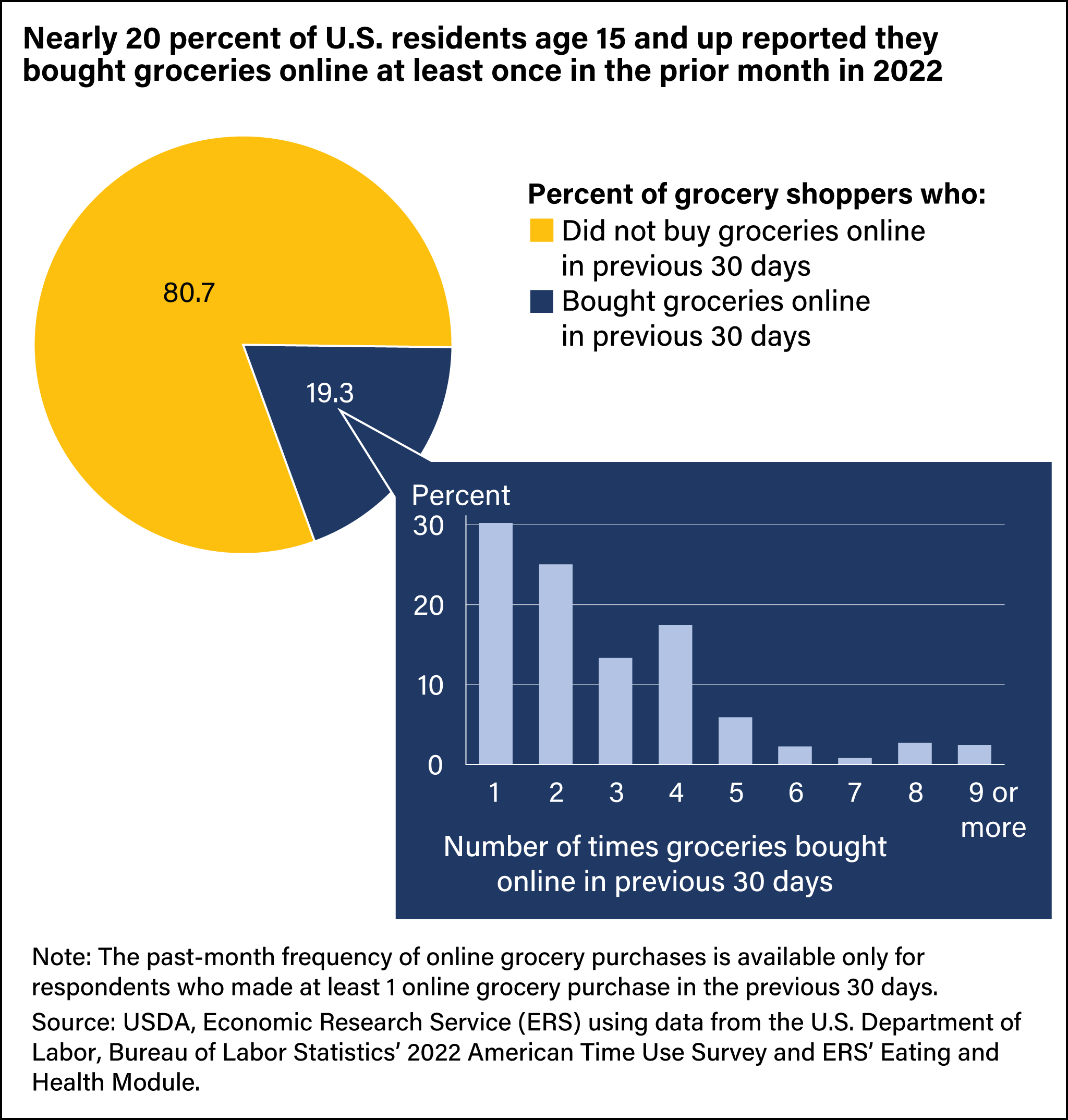
New Survey Data Show Online Grocery Shopping Prevalence and Frequency in the United States
- by Brandon J. Restrepo and Eliana Zeballos
- 2/8/2024
Since 2006, the USDA, Economic Research Service (ERS) has collected data on time use and eating patterns through the ERS-developed Eating and Health Module of the U.S. Department of Labor Bureau of Labor Statistics’ American Time Use Survey (ATUS). This module has been included as a supplement to the ATUS in 2006–08, 2014–16, and 2022–23. This dataset encompasses a wide array of information, including secondary eating—that is eating while doing another activity considered primary by the respondent—height and weight, physical activity, self-assessed diet quality and health status, USDA food assistance program participation, grocery shopping, and meal preparation. These survey data can help inform analysis on the determinants of dietary intake and diet-related health status.
In 2022, the Eating and Health Module captured for the first time nationally representative data concerning the prevalence and frequency of U.S. residents who report shopping for groceries online. The survey data revealed that nearly 9 out of 10 individuals aged 15 and older (87.2 percent) reported they usually grocery shopped for their household, either online or in-person. Of these, approximately 2 in 10 (19.3 percent) had bought groceries online at least once in the last 30 days. However, the frequency of online shopping varied. Among those who had bought groceries online in the past month, 30.2 percent did so once, 25.1 percent made two online grocery purchases, and 44.7 percent purchased groceries online three or more times.
Notably, the landscape of online grocery shopping experienced a seismic shift in early 2020 with social-distancing guidelines and stay-at-home orders issued in response to the coronavirus (COVID-19) pandemic. According to the Food and Drug Administration (FDA), online grocery sales in the United States grew 55 percent, from $62 billion in 2019 to $96 billion in 2020. The USDA’s Supplemental Nutrition Assistance Program (SNAP) also began expanding an Online Purchasing Pilot in 2020 that became available to SNAP recipients in all States except Alaska by March 2022, allowing households in participating States to use their SNAP benefits to buy groceries online from authorized, participating retailers. How individuals buy their food and groceries may continue to evolve, and survey data from the Eating and Health Module can help measure those changes.
This article is drawn from:
- Eating and Health Module (ATUS). (n.d.). U.S. Department of Agriculture, Economic Research Service.
You may also like:
- Zeballos , E. & Restrepo, B.J. (2022, October 26). People Working From Home During the Pandemic Spent Less Time Eating Away From Home. Amber Waves, U.S. Department of Agriculture, Economic Research Service.
- Food Choices & Health. (n.d.). U.S. Department of Agriculture, Economic Research Service.
- Zeballos , E. & Restrepo, B.J. (2021, February 1). Working From Home Leads to More Time Spent Preparing Food, Eating at Home. Amber Waves, U.S. Department of Agriculture, Economic Research Service.
- Jones, J.W. (2022, September 6). Supplemental Nutrition Assistance Program Online Purchasing Expanded in First Two Years of Pandemic. Amber Waves, U.S. Department of Agriculture, Economic Research Service.
- Zeballos , E., Todd, J.E. & Restrepo, B.J. (2019, September 3). ERS-Funded Eating and Health Module Paints Fuller Picture of How Much Time Americans Spend Eating. Amber Waves, U.S. Department of Agriculture, Economic Research Service.
- Zeballos , E. & Restrepo, B.J. (2018). Adult Eating and Health Patterns: Evidence From the 2014-16 Eating & Health Module of the American Time Use Survey. U.S. Department of Agriculture, Economic Research Service. EIB-198.
- Zeballos , E., Todd, J.E. & Restrepo, B.J. (2019). Frequency and Time of Day That Americans Eat: A Comparison of Data From the American Time Use Survey and the National Health and Nutrition Examination Survey. U.S. Department of Agriculture, Economic Research Service. TB-1954.


